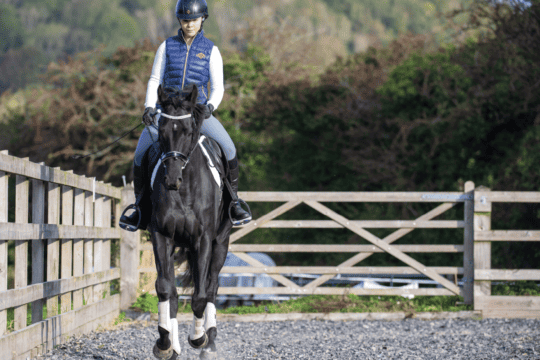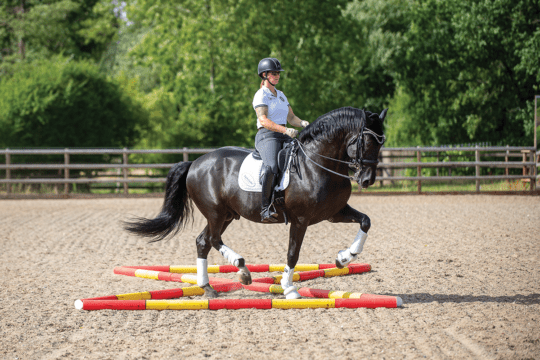Create balance, presence and self-carriage by making your horse uphill. Dressage rider Paul Friday shows you how
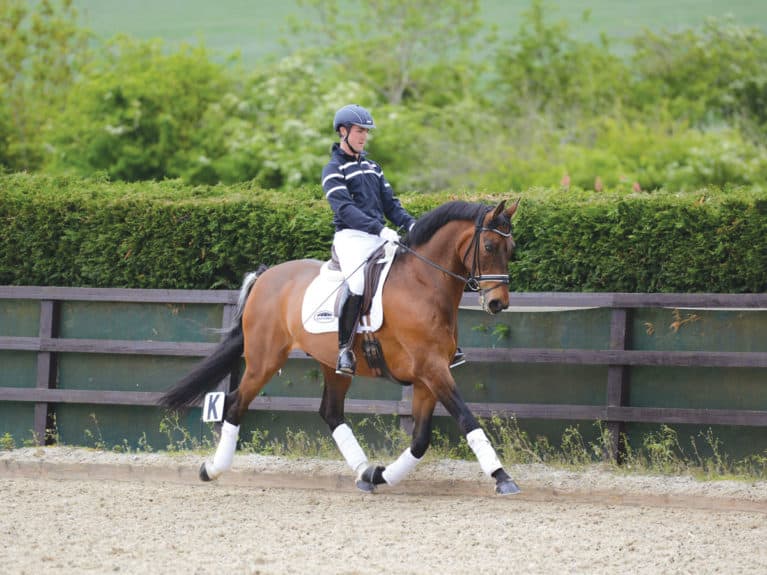
A riderless horse will carry approximately two-thirds of his bodyweight on his forelegs. Add the weight of a rider positioned closer to the front than the back and it’s easy to understand why horses can sometimes look like they’re being ridden downhill, into the ground, which is also known as being on the forehand. When you watch professional riders, their horses appear to have their weight equally distributed between their front and back legs. In top level competition, it’s desirable for even more of their weight to be on their back end for complex movements such as canter pirouettes. The good news is that it’s possible, through training, to make a naturally downhill horse more expressive with his shoulders, which instantly makes him look more uphill.
Qualities of an uphill horse
An uphill horse will…
- feel light in your hands
- be easier to ride
- feel supple and mobile
- find exercises easier
- be able to bring his hindleg underneath himself
- become more balanced
- find his work less strenuous on his joints
Identifying that he’s downhill
He’s likely to be downhill if…
- his footfall seems heavy
- he feels heavy in your hands
- he’s tense in his frame and neck
- he’s strong on one side
- he feels like he wants to run away from you
- he’s difficult to control
An uphill struggle
To make sure he’s uphill, you need to ensure he’s taking his weight behind and developing expressive paces.
It’s important to find the rhythm that suits your horse and make adjustments within his natural pace. If you want to make him more uphill, look for tempo and energy in his paces. Without them, you’re not able to make him adjustable and you’re more likely to throw his balance out.
It’s not unusual for riders to try to slow their horse too much in an attempt to encourage him to carry more of his weight on his hindlegs. If he carries you forward with impulsion, it’s a sign that he’s happy being forward within the pace, and if you slow him too much, you’ll unbalance him and he’s likely to end up even more on the forehand.
Focus his energy
A good-quality walk can be difficult for some horses and, invariably, if they struggle with it they’re likely to lose focus and become tense. If your horse becomes tight, can’t track up, or is stiff through his back during the beginning of a test or training session, he’ll find it hard to relax. To prevent this happening, encourage your horse forward into trot or canter, and allow him to get loose, focused, confident and relaxed before asking him to produce any controlled walk work. It’s important that he stays loose through his back so that he can take the weight effectively on his hindquarters.
On the up and up
It’s easier for your horse to produce a quality canter on a 10-metre circle than on the straight, due to the slight bend through his body and the direction of travel. Use your warm up to get him moving in circles, engaging his hindlegs so that when you ask him to go straight, you’ll have a much better quality canter.
You won’t be able to encourage him to become more uphill if he’s behind your leg. Make sure he’s in front of your leg by riding lots of transitions. Look at his ears and his neck to ensure he’s straight and up in front. Vary between a competition frame – where he’s compact with his poll as the highest point – and a training frame – where he’s a little bit lower in the head carriage – to check that he’s not relying on you to hold him up, which would indicate that he’s heading downhill.
Top tip
Throughout all these exercises, using a half-halt can help lighten his forehand and improve control. To ride one, make sure he stays in front of your leg, close your fingers on the reins and then release. Be careful not to slow him too much, however, as it can upset his natural rhythm.
Lateral to lift
In trot, leg-yield from the centre line to the outside track. Continue trotting straight along the long side for a few strides, then ride shoulder-in until you reach the corner. After the corner, trot straight again.
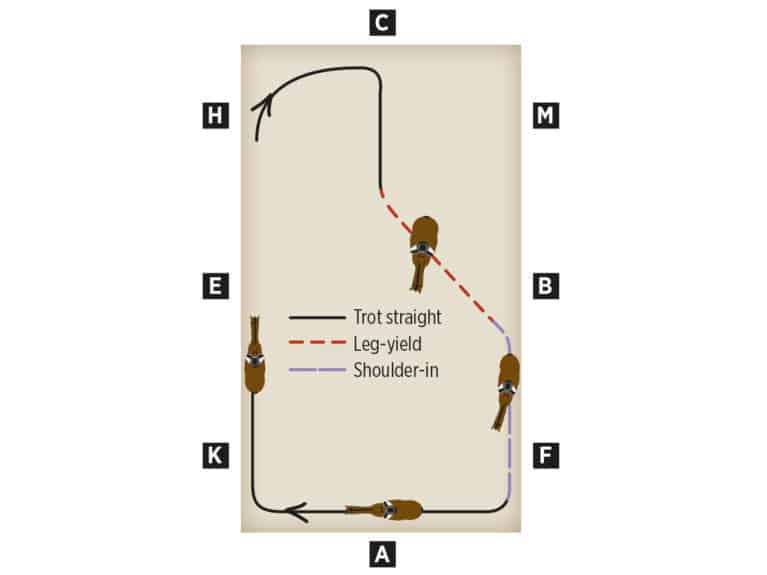
This exercise will encourage your horse to engage his hindlegs and accept your outside rein. This has the effect of making him lighter through his shoulders, so when you ride straight at the end of the exercise, he’ll be in front of your leg. By only performing a short section of each movement – leg-yield and shoulder-in – you will keep him light and active.
Objectives
- Encourage him to activate his hindquarters
- Make him feel lighter through his shoulders
- Bring him in front of your leg
Top tip
Gently touching your horse on the top of his bottom with your schooling whip encourages him to lift his hocks, rather than using too much leg aid.
Extend and collect
If your horse is already quite established with his flatwork, play with his paces to encourage him to propel himself forward, then come back to a slower, more collected gait. You can vary the speed of his pace over a few strides and, as he gets stronger, ask him to maintain a faster or slower pace for a longer period of time, without falling onto his forehand. This exercise is better performed on the track because it’ll help keep him balanced.
Start by establishing his rhythm in trot from E to C. From C to B, compress his stride while maintaining an uphill carriage. At B, you can check and rebalance him by riding a 10-metre circle and then pick the same, condensed pace up from B to F. At the corner, ask him to power forward to E where, if necessary, you can ride another 10-metre circle to rebalance him.
When you come back to the collected pace, keep the contact soft and ensure he’s not leaning onto the bit. This tells you that he is remaining in self-carriage.
As well as shortening and lengthening his strides, you can play with the tempo of his paces, too. Upping the cadence of his footfall will remind him to be responsive and keep him interested in his work.
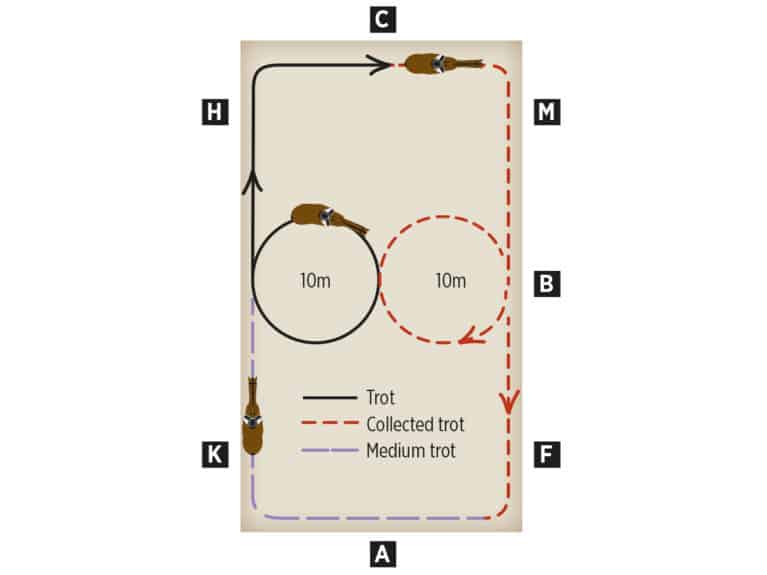
Lengthened strides
Your aim is to increase lift and ground cover. To achieve this, push him on with your legs and then relax them, so he knows that he can move forwards. Keep your outside rein consistent, too – don’t give it away.
You’ll feel activity throughout his body, like you’re being thrown upwards from the saddle a little bit more than normal with the power from his stride. He should grow through his withers and shoulders. Avoid pushing him too far out of his usual pace, because you’ll push him out of balance.
Shortened strides
To shorten his stride, sit back a little bit and deep into the saddle. Use the inside rein to soften him, and prevent him tensing and tightening through his neck. You’re aiming for a feeling of compression while still remaining relaxed. He’ll cover less ground, but you are still aiming for him to stay high through his shoulders and not fall onto his forehand, and the rhythm shouldn’t change.
Problem: He hollows and resists
If you bring him back to a steadier pace and he hollows through his back, ride a 10-metre circle in his normal rhythm to encourage him to relax again. He should feel loose in his frame, stay in the contact consistently, and keep the rhythm, balance, lift and cadence in the stride. If he doesn’t feel like he’s got those elements, ride a circle and try again.
Objectives
- Develop an adjustable stride
- Encourage better self-carriage
- Prevent him falling onto the forehand
Top tip
If your horse is very green or if you’re still working on his straightness, avoid this exercise because you can upset his natural rhythm. Instead, use lots of transitions, focusing on keeping him light in the reins and responsive to your leg aids.
Quarters-in to shoulder-fore
Pick up canter, ensuring that he’s balanced and responsive. Ride quarters-in from M to B. At B, straighten his body and ride a 10-metre circle in canter. Then ride shoulder-fore from B to F, concentrating on achieving a more uphill canter. Using quarters-in in the canter encourages his hindlegs underneath his body and flexion to the inside.
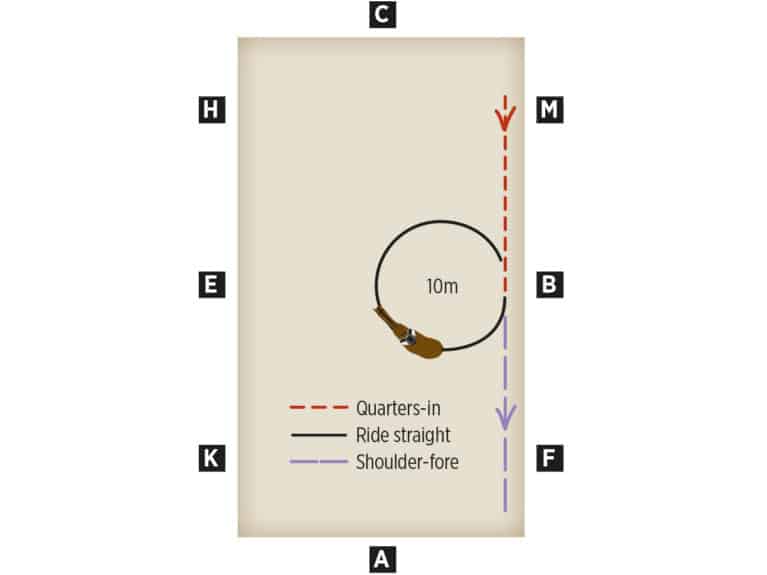
To make this exercise harder for a more experienced horse, ride travers from M to B and ride shoulder-in on the 10-metre circle. However, watch out for his quarters overtaking his shoulders when performing the quarters-in. If he starts to sidestep, his quarters start to come onto the inside track or he begins to tighten up, ride straight and repeat the circle. Make sure he maintains his rhythm and stays loose or you’ll lose the quality of his canter.
Objectives
- Encourage flexibility
- Create an uphill movement by lightening the forehand
- Progress to more advanced lateral work
Today’s lesson covered…
- Creating an adjustable stride
- Improving his balance
- Developing better hindleg engagement
- Readjusting the balance of a downhill horse
- Developing better expression and extravagance from his shoulders




